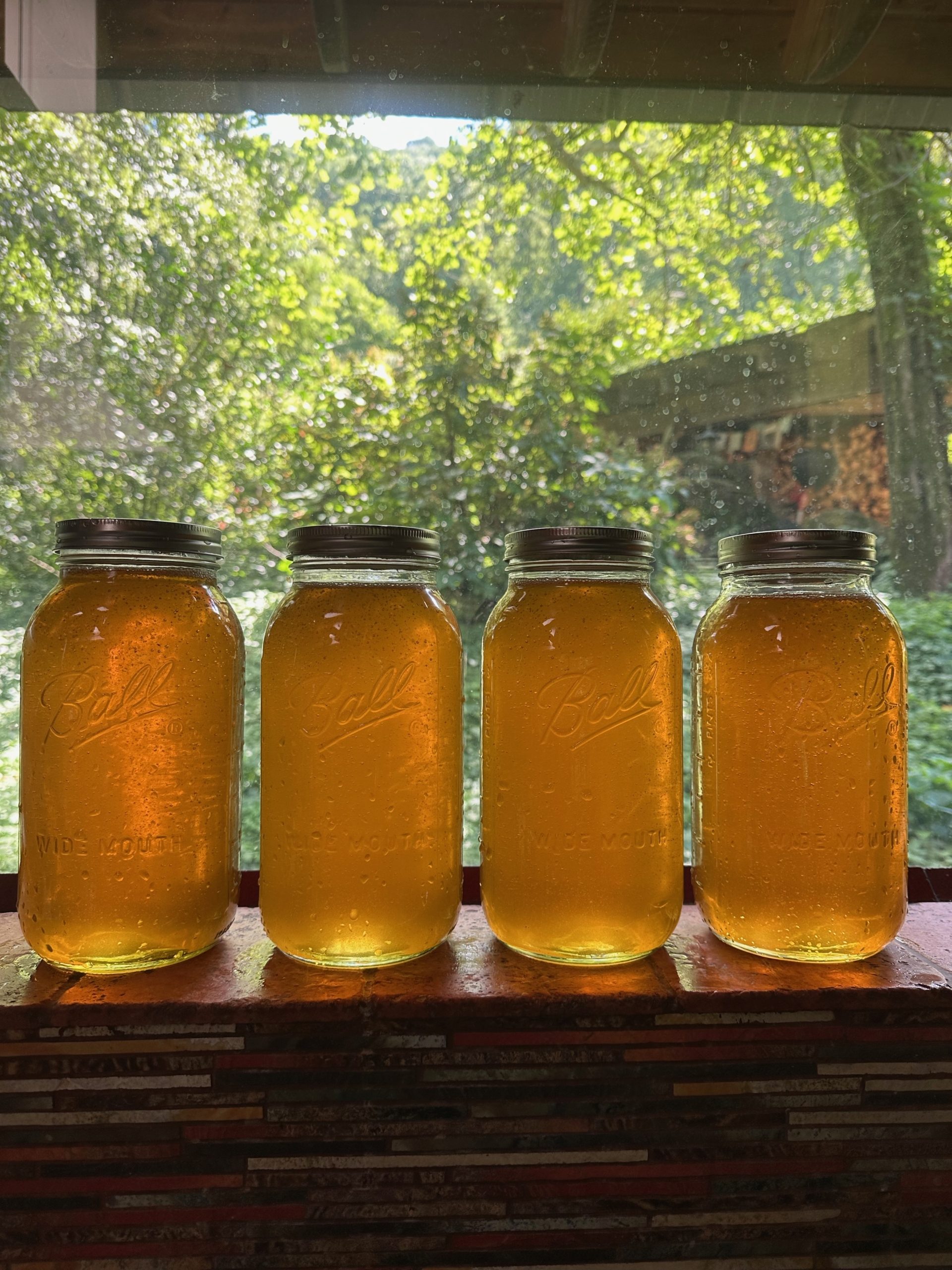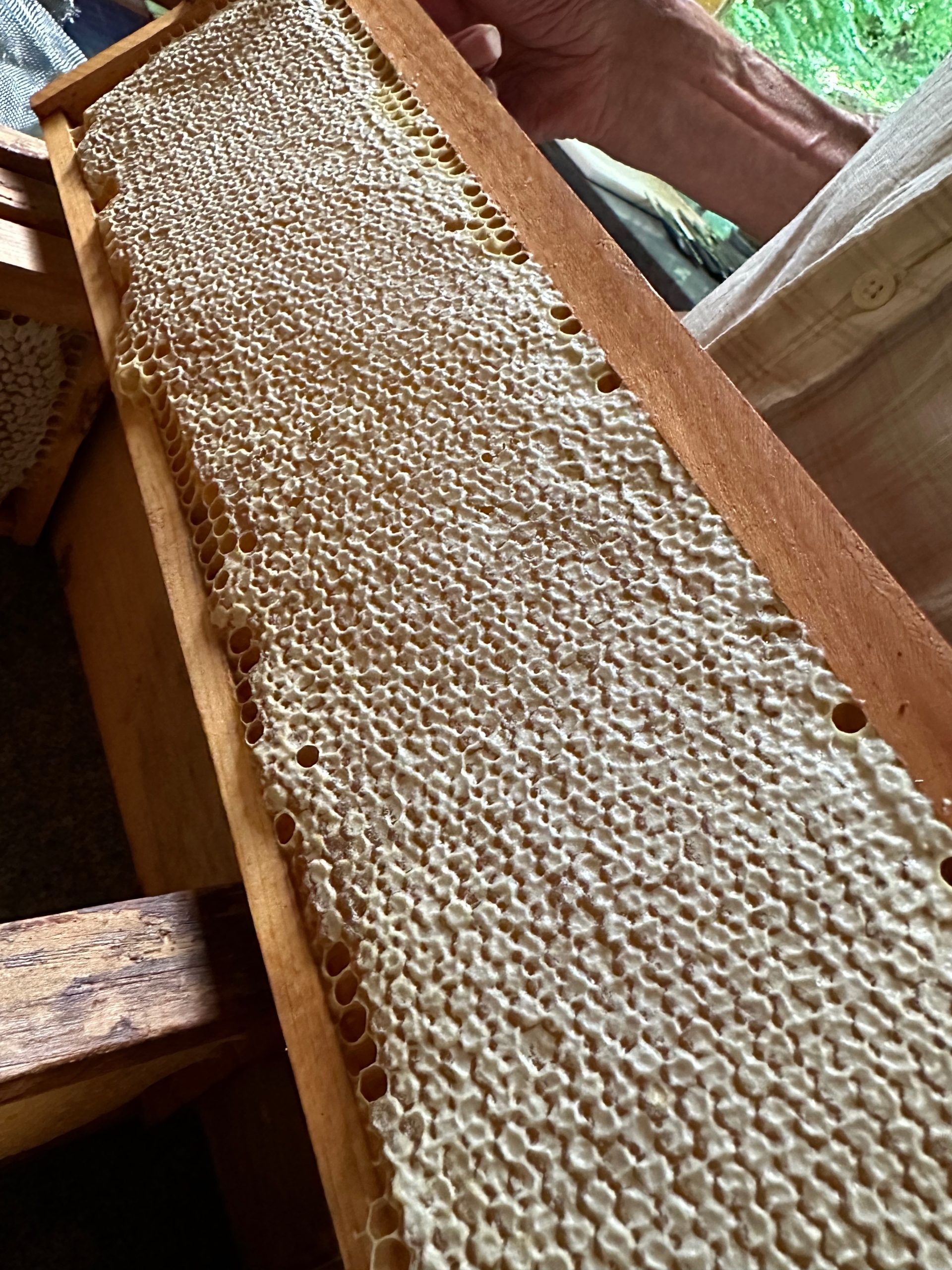Honeybees & Beekeepers
“That which is not good for the swarm, neither is it good for the bee.”
-Marcus Aurelius
Beekeeping is estimated to be as old as 5,000 years, although archeological records show we were robbing wild hives long before we kept them, bringing back the golden sweetness to our hearths. I can fully imagine the excitement everyone must have had to taste that ambrosia, big grins spreading all around, especially on the children’s faces. Honey is truly precious. And magical. If kept sealed well, it doesn’t go bad for eons. Edible honey has been found inside ancient Egyptian tombs! Is there any other food that can remain deliciously edible for thousands of years?!
I once attended a lecture by Ross Conrad on Natural Beekeeping, as I have been curious about keeping bees and thought it may be something I do when I retire (hahaha). Then I married a man who is a beekeeper. At his peak of beekeeping, Hart had about 15 hives and sold jars of honey at the farmers market and cases of honey to Dinner for the Earth, (the grocery store that eventually changed its name to Earth Fare.) One hive fluctuates from approximately 50,000-150,000 bees depending on the time of year, so that’s a lotta bees! But we have not had much success in recent years as the bees are not doing well and thriving like they used to, in way more places than just our farm.
Ross offers beekeeping workshops in the Northeast, on how to holistically care for bees by respecting them and their needs, quite the opposite of what most bee farmers of this country are doing. He talks about what Hart has always done, which is using herbs instead of antibiotics and synthetic chemicals for diseases and mites, and only taking up to half the honey harvest, leaving plenty of food for the bees to get themselves through the winter. We recently watched a documentary called Honeyland about one of Europe’s last female bee-hunters and how her livelihood was crushed by the greed and flippant practices of nomadic beekeepers who moved in nearby. It is both heart-breaking and awe-inspiring, and gave me yet another lens for appreciating the gift of the honeybees.

Hart was 19-years old when he began keeping bees. He was interested in all types of self-sufficiency and going back to the land and he said beekeeping just seemed like a natural part of that. He mail ordered a package of bees and even though he had read book after book on how to care for them, the beehive kept diminishing. He called on a neighbor, Mr. Holcomb, who said the problem was there wasn’t a queen in the hive, so something had killed the Queen. The colony eventually died and then Hart caught a swarm and tried again. He built up hive after hive until he had over a dozen.
Hart’s abundant hives were nestled in what we now affectionately call the Honey Orchard, when he moved to California in 1988. A neighbor had agreed to take care of them in his absence, but when he returned a few years later, the hives were neglected and covered up in weeds and only a couple had survived.
In 2010, Hart began increasing his hives again and for 3 years he had about 10, which he kept near the pear tree by the Hearth House. One night, a bear came and marauded a hive until our neighbor banged on pots and pans and scared it away. The queen had miraculously survived so Hart was able to save that hive, even though the bear had taken a bunch of its honey. And for the first time in his beekeeping life, Hart installed an electric fence around his hives.

There was a lot of honey to harvest in those years, so he got a honey extractor. I remember the mess we made, getting all the honey off the supers and jarring it up, and all the bees that kept getting in the house each time the door opened and us trying to guide them out again. We had gallons and gallons and shared it generously. Nowadays, a quart of local honey sells for around $20. I remember just 20 years ago, buying a gallon at a time, for only $20!
Research has shown that an average bee will make only 1/12 teaspoon of honey in her lifetime, meaning 12 bees make only one teaspoon of honey. One quart of honey represents the lifework of over 2,300 bees! I often think of this when I consume honey, and am filled with gratitude.
The stinging honeybees we are accustomed to working with are originally from Europe, but there are many different types of honey-producing bees and wasps, many of whom are stingless. The Melipona bees of Meso America are an example of one kind, and, like many native pollinating insects, are endangered. The Mayan Melipona Bee Project is an organization committed to protecting these native insects and the women beekeepers who steward them for their honey. When we were in Costa Rica recently, we bought some honey from a man who gets it from wasps. It is so important to encourage and support the diversity of honey-making creatures, not just Apis mellifera.
In 2014, Hart lost 5 hives in one spring. He noticed there was no activity, not even on warm days, and when he checked the hive and saw there was not a bee left. It was still full of honey, but not a bee. The other bees that were left wouldn’t eat the honey and so he thought it must not be good for our consumption either. The bees absconded- there were no mites, no ant invasions, no lack of forage for sure, but they were gone. The next year, the rest of the hives did the same. A complete die-off.
Hart cleaned all his hives and tried to start over several times, catching swarms, but every spring, they would all be gone, leaving the honey behind. By 2017, he just gave up. I am not a beekeeper, so I can’t say what is going on, but clearly something is not right.
Almost 5 years later, Hart decided to try again when our electrician, Keith, kindly gave him two hives. One quickly dissipated, but the other thrived. Then, one summer day, at least a million bees showed up here- they were all over the property, on the buildings, in the trees, on the ground- there was a steady hum you could hear all over the land. Oddly enough, Keith was here that day working on an electrical project, and both he and Hart were astounded. Neither had experienced anything like this in their lives! Within an hour, the entire bottom of our one precious hive was covered in beeswax caps. The other bees had broken in and stolen all the honey from the hive. And all of our bees fled.
Hart was heartbroken and said he wasn’t going to try anymore. But then…
On Beltane this year, Nadia and I were in the Glad Garden setting up a table of food for my women’s group when we heard a loud hum. We followed the sound with our eyes and saw a swarm of bees headed our way. I had a small bonfire going and the swarm was headed straight to it. Once they got over the fire, they split up, and it was fascinating to watch them all come back in unison again on the other side and fly up into the pear tree above my garden, in the Honey Orchard, no doubt!
Nadia ran to find Hart and tell him, and, of course, being the tenacious man he is, he couldn’t help but catch them and try yet again! And they are doing so well~ We just harvested 30 pounds of Sourwood Honey from this 1st year swarm. Swoon!

For Sourwood, Hart places a super on the hive well before the Sourwood trees begin to bloom, usually the first two weeks of July, and if all goes well weather-wise, that light, golden, prized honey fills up the combs. And it did!
Honeybees form their combs in the shape of hexagons, making their structures the most efficient storage units in the world. Even though the comb is quite light, it can hold a substantial amount of weight as well as allow the packing in of volume without leaving any empty space between cells. Brilliant beings.

What will be the full story of this hive? Will it make it through the winter and still thrive? Even though we are an organic farm, the bees travel up and down the road and get exposed to neonicotinoide insecticides and who knows what all else. The future of beekeeping and wild harvesting honey is all interconnected with each and every one of our decisions. “Pull a thread here and you will find it’s attached to the rest of the world.”
-Nadeem Aslam



